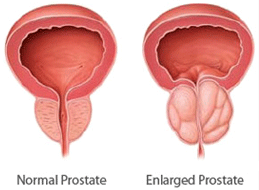When men middle-aged or elderly men have some difficulty with urination, their doctor’s attention will usually focus on their prostate – the gland that encircles the pipe that takes urine from the bladder to the outside known as the urethra. An enlarged prostate can impinge on the outflow of urine from the bladder and therefore cause symptoms such as frequency (needing to pass water frequently), nocturia (passing urine at night), hesitancy (having difficult getting urination going) and ‘post micturition dribbling’ (‘leaking’ after urination). See the diagram below for the relevant anatomy.
I read a recent review of the management of ‘lower urinary tract symptoms’ in men published in the British Medical Journal [1]. No surprisingly, it focuses a lot on prostatic enlargement (the most common for of which is non-cancerous and usually referred to as ‘benign prostatic enlargement’ or ‘BPH’).
However, I find it’s not uncommon for men to have urinary symptoms that do not stem from the prostate. In other words, I’ve seen men in practice who have symptoms of ‘BPH’ but have no evidence of BPH. This phenomenon, I think, does not get the recognition it deserves.
I was therefore interested and pleased to see the inclusion of the following paragraph in the BMJ piece:
In addition, although lower urinary tract symptoms are associated with urinary flow and prostate size, there is substantial evidence that men can have symptoms even in the absence of BPH, enlarged prostate on physical examination, or abnormal urinary flow rates. This is partly because lower urinary tract symptoms can be caused by multiple mechanisms, including prostate and bladder smooth muscle tone and contractility. Moreover, the prevalence of lower urinary tract symptoms in women is not too dissimilar to that in men. Thus, although lower urinary tract symptoms in older men are often attributed to BPH, clinicians should consider other causes in their diagnosis and evaluation…
Notice this sentence in particular: “the prevalence of lower urinary tract symptoms in women is not too dissimilar to that in men.” Women don’t have prostates, so what causes lower urinary tract symptoms here, and could there be similar issues in some (perhaps many) men?
In women, urinary symptoms are often recognised to be the result of dysfunction in the bladder. Here, the bladder (which is essentially a muscular bag) can be ‘overactive’, and this can cause a symptom known as urgency, which basically means there is strong desire to urinate and the need to get to a toilet quickly. It’s not uncommon for individuals with this symptom to get caught short, giving rise to something known as urge incontinence.
Women are usually the prime suspects for urge incontinence, because childbirth is believed to have the ability to change the muscles at the base of the pelvis (pelvic floor muscles) in a way that can impair continence. However, I think bladder dysfunction is common in men, and often gets missed because of we doctors’ tendency to focus on the prostate.
By way of example, I saw a man some years ago with urinary symptoms, mainly of the “urgency” type. He had had his prostate investigated, and it had been concluded that while this was moderately enlarged, this might not actually explain his symptoms. Actually, in my opinion, his symptoms suggested an overactive bladder, which means his enlarged prostate may well be a red herring.
Over the years, I have discovered that an overactive bladder is very often related to a deficiency of the mineral magnesium. Magnesium is very important for normal muscular function, and a deficiency of it can cause muscles to be prone to spasm. So, this may cause the bladder to be overactive, but it can also cause symptoms in other muscles too including the skeletal muscles. Symptoms I look out for here are a tendency to cramp, tight muscles and ‘restless legs’ (a problem which tends to be most obvious when individuals are trying to get to sleep in bed at night).
I generally recommend that individuals with symptoms of an overactive bladder try upping their magnesium intake, and this is especially the case where there are other symptoms suggestive of magnesium deficiency. Nuts are a good source of magnesium, though for speedier results I find it helps to supplement too at a dose of about 400 mg of elemental magnesium per day.
References:
1. Hollingsworth JM, et al. Lower urinary tract symptoms in men. BMJ 2014;349:g4474
